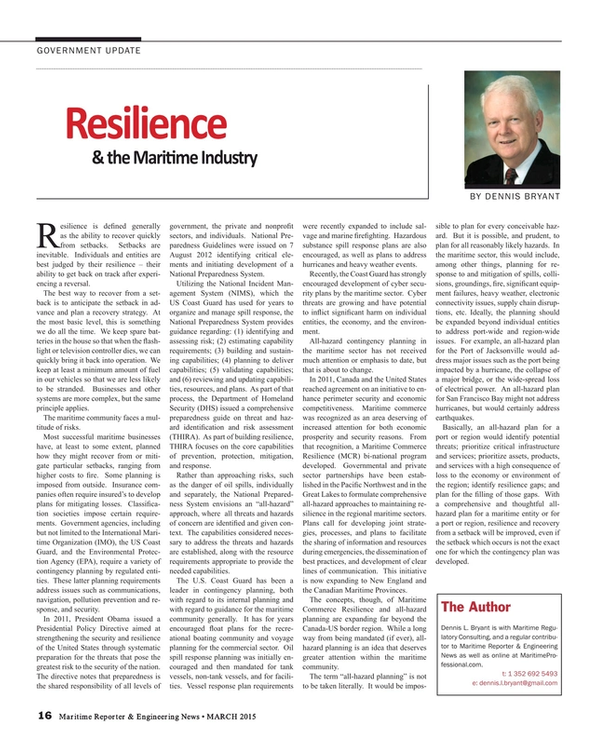
Resilience & the Maritime Industry
Resilience is defined generally as the ability to recover quickly from setbacks. Setbacks are inevitable. Individuals and entities are best judged by their resilience – their ability to get back on track after experiencing a reversal.
The best way to recover from a setback is to anticipate the setback in advance and plan a recovery strategy. At the most basic level, this is something we do all the time. We keep spare batteries in the house so that when the flashlight or television controller dies, we can quickly bring it back into operation. We keep at least a minimum amount of fuel in our vehicles so that we are less likely to be stranded. Businesses and other systems are more complex, but the same principle applies.
The maritime community faces a multitude of risks.
Most successful maritime businesses have, at least to some extent, planned how they might recover from or mitigate particular setbacks, ranging from higher costs to fire. Some planning is imposed from outside. Insurance companies often require insured’s to develop plans for mitigating losses. Classification societies impose certain requirements. Government agencies, including but not limited to the International Maritime Organization (IMO), the US Coast Guard, and the Environmental Protection Agency (EPA), require a variety of contingency planning by regulated entities. These latter planning requirements address issues such as communications, navigation, pollution prevention and response, and security.
In 2011, President Obama issued a Presidential Policy Directive aimed at strengthening the security and resilience of the United States through systematic preparation for the threats that pose the greatest risk to the security of the nation. The directive notes that preparedness is the shared responsibility of all levels of government, the private and nonprofit sectors, and individuals. National Preparedness Guidelines were issued on 7 August 2012 identifying critical elements and initiating development of a National Preparedness System.
Utilizing the National Incident Management System (NIMS), which the US Coast Guard has used for years to organize and manage spill response, the National Preparedness System provides guidance regarding:(1) identifying and assessing risk; (2) estimating capability requirements; (3) building and sustaining capabilities; (4) planning to deliver capabilities; (5) validating capabilities; and (6) reviewing and updating capabilities, resources, and plans. As part of that process, the Department of Homeland Security (DHS) issued a comprehensive preparedness guide on threat and hazard identification and risk assessment (THIRA). As part of building resilience, THIRA focuses on the core capabilities of prevention, protection, mitigation, and response.
Rather than approaching risks, such as the danger of oil spills, individually and separately, the National Preparedness System envisions an “all-hazard” approach, where all threats and hazards of concern are identified and given context. The capabilities considered necessary to address the threats and hazards are established, along with the resource requirements appropriate to provide the needed capabilities.
The U.S. Coast Guard has been a leader in contingency planning, both with regard to its internal planning and with regard to guidance for the maritime community generally. It has for years encouraged float plans for the recreational boating community and voyage planning for the commercial sector. Oil spill response planning was initially encouraged and then mandated for tank vessels, non-tank vessels, and for facilities. Vessel response plan requirements were recently expanded to include salvage and marine firefighting. Hazardous substance spill response plans are also encouraged, as well as plans to address hurricanes and heavy weather events.
Recently, the Coast Guard has strongly encouraged development of cyber security plans by the maritime sector. Cyber threats are growing and have potential to inflict significant harm on individual entities, the economy, and the environment.
All-hazard contingency planning in the maritime sector has not received much attention or emphasis to date, but that is about to change.
In 2011, Canada and the United States reached agreement on an initiative to enhance perimeter security and economic competitiveness. Maritime commerce was recognized as an area deserving of increased attention for both economic prosperity and security reasons. From that recognition, a Maritime Commerce Resilience (MCR) bi-national program developed. Governmental and private sector partnerships have been established in the Pacific Northwest and in the Great Lakes to formulate comprehensive all-hazard approaches to maintaining resilience in the regional maritime sectors. Plans call for developing joint strategies, processes, and plans to facilitate the sharing of information and resources during emergencies, the dissemination of best practices, and development of clear lines of communication. This initiative is now expanding to New England and the Canadian Maritime Provinces.
The concepts, though, of Maritime Commerce Resilience and all-hazard planning are expanding far beyond the Canada-US border region. While a long way from being mandated (if ever), all-hazard planning is an idea that deserves greater attention within the maritime community.
The term “all-hazard planning” is not to be taken literally. It would be impossible to plan for every conceivable hazard. But it is possible, and prudent, to plan for all reasonably likely hazards. In the maritime sector, this would include, among other things, planning for response to and mitigation of spills, collisions, groundings, fire, significant equipment failures, heavy weather, electronic connectivity issues, supply chain disruptions, etc. Ideally, the planning should be expanded beyond individual entities to address port-wide and region-wide issues. For example, an all-hazard plan for the Port of Jacksonville would address major issues such as the port being impacted by a hurricane, the collapse of a major bridge, or the wide-spread loss of electrical power. An all-hazard plan for San Francisco Bay might not address hurricanes, but would certainly address earthquakes.
Basically, an all-hazard plan for a port or region would identify potential threats; prioritize critical infrastructure and services; prioritize assets, products, and services with a high consequence of loss to the economy or environment of the region; identify resilience gaps; and plan for the filling of those gaps. With a comprehensive and thoughtful all-hazard plan for a maritime entity or for a port or region, resilience and recovery from a setback will be improved, even if the setback which occurs is not the exact one for which the contingency plan was developed.
The Author
Dennis L. Bryant is with Maritime Regulatory Consulting, and a regular contributor to Maritime Reporter & Engineering News as well as online at MaritimeProfessional.com.
t: 1 352 692 5493
e: [email protected]
(As published in the March 2015 edition of Maritime Reporter & Engineering News - http://magazines.marinelink.com/Magazines/MaritimeReporter)
Read Resilience & the Maritime Industry in Pdf, Flash or Html5 edition of March 2015 Maritime Reporter
Other stories from March 2015 issue
Content
- Editorial: The MAN in Command page: 6
- Getting Onboard the Regulatory Train page: 8
- Moskito to Recover Oil from Sunken Wrecks page: 10
- Studies Show U.S. Offshore’s Untapped Potential page: 12
- Big Spending on Liquefaction Terminals page: 13
- Using AIS Data to Assess Collision Risks page: 14
- Resilience & the Maritime Industry page: 16
- EALs & Oil Spill Remediation page: 18
- Imtech Marine USA and Radio Holland ‘Reloaded’ page: 20
- Maritime Training Five Years from Now: A Look Ahead page: 22
- Turkey Maritime Sector Alive & Kicking page: 24
- Schmiedag and Wildauer Schmiedewerke: 'We Forge Partnerships' page: 26
- SimCity page: 31
- Maritime Simulation “A-to-Z” page: 38
- USCG Adm. Zukunft: The Man, His Mission page: 40
- USCG Makes Headway in Challenging Waters page: 48
- US Tank Barge Regs Loom, Laborde Presses Mitsubishi’s 'Mechanical Advantage' page: 52
- Coast Guard Foundation Supports USCG Men, Women, Families page: 53
- Marine Salvage & Oil Spill Response Insights page: 54
- Oil Under Ice page: 56
- Greek Fleet (Still) Rules page: 60
- Push Boats: From Turkey to Brazil page: 62
- LNG Barge: Conrad to Build Historic First page: 63
- Light-Off for Pasha’s New ConRo page: 63
- Imabari Invests in Shipbuilding page: 64
- Thunderbolt: Eastern Delivers Innovative Towboat page: 64
- MLP3 AFSB NASSCO Delivers for the Navy page: 65
- How to Approach Maritime Cyber Security page: 66
- Terragon: Next-Step in Ship Waste Handling page: 68


